
Gobiodon is a genus of gobies also known as coral gobies or "clown gobies". Generally, coral gobies, unlike the rest of the family Gobiidae, are not burrowers, but instead prefer to inhabit the branches of certain Acropora or similar hard corals.
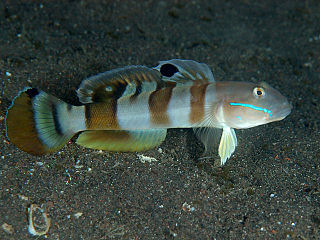
Valenciennea is a genus of small, bottom-dwelling fish in the family Gobiidae. They are found over sandy bottoms, often at coral reefs in the Indo-Pacific. The members of the genus tend to rest directly on the substrate for extended periods of time. While this is a common behavior for members of the family, this genus also float motionless directly above the substrate, which is why they are sometimes called glider gobies. Their resting behavior has resulted in the vernacular name "sleeper gobies", which invites confusion with the related family Eleotridae. The members of this genus are known to be carnivorous sand-sifters; to eat, they simply engulf entire mouthfuls of sand which they expel through their gills. Specialized structures in their gills filter small crustaceans and worms as the sand is expelled. It is this specific trait that makes some members of the genus attractive to the marine aquarist, and they are often introduced into a marine aquarium for sand-sifting. Some of the species are known to be monogamous. The genus was named after notable French zoologist Achille Valenciennes. These fish are difficult to keep in a tank. Tanks with plenty of live sand and live rock are recommended. Offer foods such as sinking shrimp pellets. Fish may die even if eating properly.
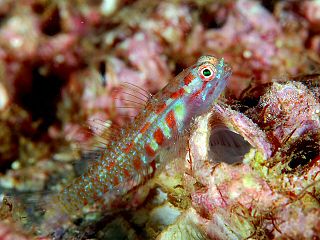
Eviota is a genus of fish in the family Gobiidae, commonly as dwarfgobies found in the Indo-Pacific region, where it is distributed from Japan to Australia and from Africa to Pitcairn Island. Species are mainly associated with coral reefs. Many of these fish are short-lived, with life cycles as brief as 3.5 weeks in the tropics. Some species are hermaphrodites and some representatives live symbiotically among the tentacles of the mushroom coral.

Amblyeleotris is a genus of fish in the family Gobiidae found throughout the Indo-Pacific region. This is the largest genus of the shrimp gobies or prawn gobies, so-called because of their symbiotic relationship with certain alpheid shrimps. The shrimp excavates and maintains a burrow used by both animals while the goby, which has far superior eyesight, acts as a lookout for predators. The shrimp maintains almost constant contact with the fish with an antenna. These species vary considerably in size from less than 30 mm to almost 200 mm standard length.

Rhinogobius is a genus of primarily freshwater gobies native to tropical and temperate parts of eastern Asia. Most are small, streamlined in shape, and often sexually dimorphic. Few are of commercial importance, but R. duospilus is fairly widely traded as an aquarium fish.
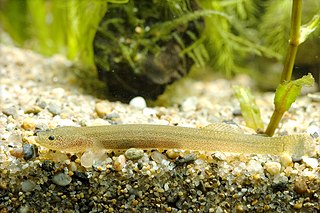
Luciogobius is a genus of goby in the subfamily, Gobionellinae. It is distributed along the coast of northeastern Asia, where species can be found in Korea, China, Taiwan, and Japan. Most species occur in Japan, and several are endemic.
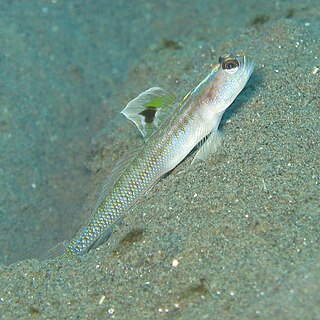
Vanderhorstia is a genus of gobies native to the Indian and Pacific oceans. The name of this genus honours the Dutch biologist Cornelius van der Horst (1889-1951) of the University of The Witwatersrand, Johannesburg, who was well known for his interest in marine biology.

The yellow prawn-goby is a species of goby native to the Western Pacific, where it can be found at depths of from 1 to 25 metres in coastal bays and lagoons. This species is symbiotic with alpheid shrimps. The species can reach a length of 10 centimetres (3.9 in) SL. These fish vary greatly in appearance, ranging from brilliant yellow to gray and even brown forms or combinations of each coloring. This species is often kept in salt water aquariums. The Yellow Prawn-Goby can be kept in aquariums as small as 20 gallons. In the marine hobby they are often partnered with Tiger pistol shrimp.

True gobies were a subfamily, the Gobiinae, of the goby family Gobiidae, although the 5th edition of the Fishes of the World does not subdivide the Gobiidae into subfamilies. They are found in all oceans and a few rivers and lakes, but most live in warm waters. Altogether, the Gobiinae unite about 1149 described species in 160 genera, and new ones are still being discovered in numbers.
Ancistrogobius is a genus of gobies native to the western Pacific Ocean.

Asterropteryx is a genus of fish in the family Gobiidae found in the Indian and Pacific Ocean.

Cabillus is a genus of gobies native to the Indian and Pacific oceans.

Chaeturichthys is a genus of gobies native to the western Pacific Ocean.
Gladiogobius is a genus of gobies native to the Indian and western Pacific oceans.

Grallenia is a genus of fish in the family Gobiidae native to the western Pacific Ocean.
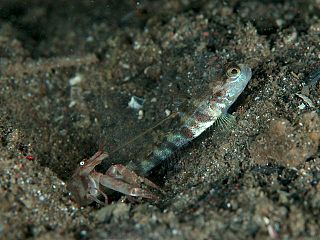
Myersina is a genus of ray-finned fish from the family Gobiidae, the true gobies which are found from the Atlantic coast of South Africa through the Indian Ocean to the western Pacific Ocean. The generic name honours the American ichthyologist George S. Myers (1905-1985) who was a younger colleague of Herre's at the time at which he described the genus and who went on to be president of the American Society of Ichthyologists and Herpetologists, the head of the Division of Fishes at the United States National Museum and an ichthyologist for the United States Fish and Wildlife Service.

Obliquogobius is a genus of gobies native to the Indian Ocean and the northwestern Pacific Ocean.
Parkraemeria is a genus of gobies native to the western Pacific Ocean from the Ryukyus to Australia.
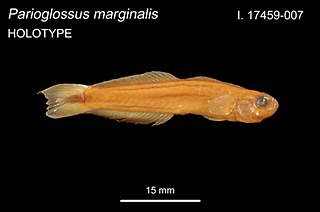
Parioglossus is a genus of dartfishes native to the Indian and Pacific oceans.
Dotsugobius bleekeri, also known as the dark mangrovegoby, is a species of fish in the family Gobiidae known from brackish estuarine and the adjacent freshwater areas of the eastern Indian Ocean, Andaman Sea and Western Pacific. The generic name honours the Japanese ichthyologist Yoshie Dotsu, whose surname was spelled “Dôtu” in his earlier publications, of Nagasaki University while the specific name honours the Dutch ichthyologist, herpetologist and physician Pieter Bleeker (1819-1878) who was a significant worker on the fish fauna of the Dutch East Indies. This species is placed in the genus Lophogobius by some authorities.















